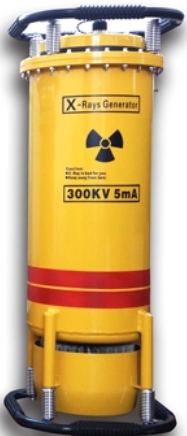
- Home
- >
News
NDT portable X-ray welding testing machine is mainly suitable for industrial sectors such as national defense, shipbuilding, petroleum, chemical, mechanical, aerospace, and construction to inspect the processing and welding quality of materials and components such as ship hulls, pipelines, high-pressure vessels, boilers, aircraft, vehicles, and bridges, as well as internal defects and the inherent quality of various light metals, rubber, ceramics, etc.
Originally Battery Accessory is a device used for electrochemical system research, belonging to X-ray diffractometer accessories,which allows real-time and dynamic monitoring and analysis of the battery under specific conditions. Widely used in electrochemical systems containing carbon, oxygen, nitrogen sulfur, metal embedded complexes, etc.
Fiber accessories are tested for their unique crystal structure using X-ray diffraction (transmission) method. Test the orientation of the sample based on the fiber crystallinity and half peak width of the fibers. This type of accessory is usually installed on a wide-angle diffractometer and is mainly used to study the texture of thin films on the substrate, perform crystal phase detection, orientation, stress testing, and other tests.
Multifunctional integrated measurement accessory is an instrument accessory that can measure multiple parameters. It is a measurement accessory for X-ray diffractometer, mainly used to improve measurement efficiency, increase measurement functions, and improve instrument maintenance. Used for analysis and testing of various materials in fields such as chemical engineering, machinery, geology, minerals, metallurgy, building materials, ceramics, petrochemicals, pharmaceuticals, etc. Multifunctional integrated measuring accessories play an important role in various fields, providing strong support for scientific research and industrial production.
Cabinet X-ray irradiator is used to irradiate cells or small animals. An X-ray irradiator is an instrument that uses high-energy X-rays to irradiate substances in order to achieve specific biological or physical effects. Used for various basic and applied research. Throughout history, radioactive isotope irradiators have been used, which require transporting samples to a core irradiation facility. Today, smaller, safer, simpler, and lower cost X-ray irradiation equipmentcan be installed in laboratories for convenient and rapid irradiation of cells. Modern X-ray irradiation equipment is equipped with comprehensive safety protection measures, such as emergency stop devices, over temperature protection, automatic preheating functions, etc., to ensure safe operation.
The TDF series X-ray crystal analyzer is a large-scale analytical X-ray instrument used to study the internal microstructure of substances.It is mainly used for single crystal orientation,defect inspection,determination of lattice parameters, determination of residual stresses, study of the structure of plates and rods, study of the structure of unknown substances, and single crystal dislocations. The TDF series X-ray crystal analyzer adopts a vertical tube sleeve, and four windows can be used simultaneously. The TDF series X-ray crystal analyzer adopts imported PLC control technology, with high control accuracy and good anti-interference performance, which can achieve reliable operation of the system. The PLC controls the high-voltage switch, lifting, and has the function of automatically training the X-ray tube, effectively extending the service life of the X-ray tube and X-ray instrument.
The TDM-20 X-ray diffractometer is mainly used for phase analysis of powders, solids, and similar paste like materials. The X-ray diffractometer can be used for qualitative or quantitative analysis, crystal structure analysis, and other polycrystalline materials such as powder samples and metal samples. X-ray diffractometer is widely used in industries such as industry, agriculture, national defense, pharmaceuticals, minerals, food safety, petroleum, education, and scientific research. Benchtop XRD is an experimental equipment used for analyzing the crystal structure of materials. Benchtop XRD determines the crystal structure, lattice parameters, and phase composition of the material by emitting X-rays and measuring the diffraction angle and intensity after their interaction with the sample.
X-ray diffractometer is mainly used for phase qualitative and quantitative analysis, crystal structure analysis, material structure analysis, crystal orientation analysis, macroscopic or microscopic stress determination, grain size determination, crystallinity determination, etc. of powder, block or film samples. The TD-3500 X-ray diffractometer produced by Dandong Tongda Technology Co., Ltd. adopts imported Siemens PLC control, which makes the TD-3500 X-ray diffractometer have the characteristics of high accuracy, high precision, good stability, long service life, easy upgrade, easy operation and intelligence, and can flexibly adapt to testing analysis and research in various industries! It is a powerful analytical tool widely used in fields such as materials science, chemistry, physics, and geology.
The TD-3700 X-ray diffractometer is a new member of the TD series, equipped with a variety of high-performance detectors such as high-speed one-dimensional array detectors, two-dimensional detectors, SDDdetectors, etc. It integrates fast analysis, convenient operation, and user safety. The modular hardware architecture and customized software system achieve a perfect combination, making its failure rate extremely low, anti-interference performance good, and ensuring long-term stable operation of high-voltage power supply. The TD-3700 X-ray powder diffractometer supports both conventional diffraction data scanning and transmission data scanning methods. The TD-3700 X-ray powder diffractometer, with all the advantages of the TD-3500 X-ray diffractometer, is equipped with high-performance detectors. Compared to scintillation detectors or proportional detectors, diffraction calculation intensity can be increased by several tens of times, and complete high-sensitivity, high-resolution diffraction patterns and higher counting intensity can be obtained in a shorter sampling period.
X-ray absorption fine structure spectrum (XAFS) is an analytical tool used to study the structure and properties of substances. XAFS obtains information about atoms and molecules in a sample by measuring the X-ray absorption of the sample within a specific energy range. XAFS is a powerful tool for studying the local atomic or electronic structure of materials.XAFS technology is widely used in materials science, chemistry, biology, and other fields, especially in research areas such as catalysis, batteries, sensors, etc. XAFS has important application value. Through XAFS technology, researchers can gain a deeper understanding of the microstructure and properties of samples, providing powerful support for the design and optimization of new materials.
X-ray single crystal diffractometer is mainly used to determine the three-dimensional spatial structure and electron cloud density of crystalline substances such as inorganic,organic,and metal complexes,and to analyze the structure of special materials such as twinning, non commensurate crystals,quasicrystals,etc.Determine the accurate three-dimensional space (including bond length, bond angle,configuration,conformation,and even bonding electron density) of new compound (crystalline) molecules and the actual arrangement of molecules in the lattice;Single crystal X-ray diffractometer can provide information on the crystal cell parameters,space group,molecular structure,intermolecular hydrogen bonding and weak interactions,as well as structural information such as molecular configuration and conformation.Single crystal XRD is widely used in analytical research in chemical crystallography,molecular biology,pharmacology,mineralogy,and materials science. Single crystal XRD has high precision: 2θ angle repeatability accuracy: 0.0001°; Minimum step angle: 0.0001°; Temperature control range:100K-300K Control accuracy: ±0.3K Single crystal angle measuring instrument selects four concentric scanning circles. Single crystal XRD adopts low-temperature configuration. The company's technical personnel have completed the installation and debugging of the foreign single crystal X-ray diffractometer,and the test results have greatly satisfied foreign users. At the same time,the functionality,stability,and after-sales service of the instrument have received unanimous praise from foreign users. Overall, X-ray single crystal diffractometer plays an irreplaceable role as an important scientific instrument in research and application in multiple disciplines. With the continuous advancement and innovation of technology, we believe that in the future,single crystal XRD will demonstrate their unique value and potential in more fields.
NDT portable X-ray welding testing machine is a type of radiographic inspection equipment that can generate X-rays and has multiple uses. Portable X-ray machine for weld inspection can be used in industrial and medical fields. In industry, it is used for defect detection in automotive parts manufacturing, wheel hub detection, subframe detection, hinge quality detection, etc., to ensure that the tested industrial products have high strength. In addition, its belongs to X-ray weld inspection equipment and is commonly used for weld detection, boiler weld detection, aerospace component weld detection, etc.












